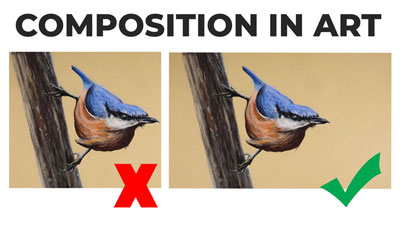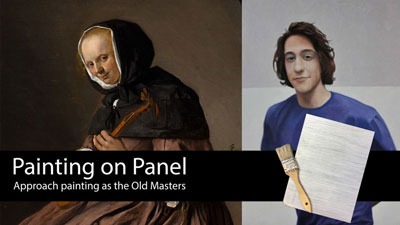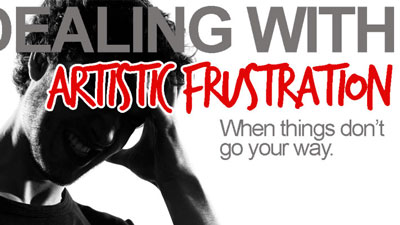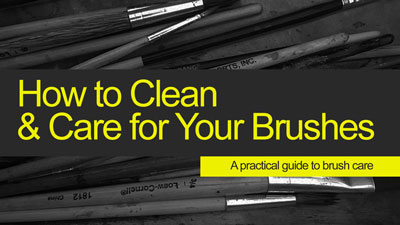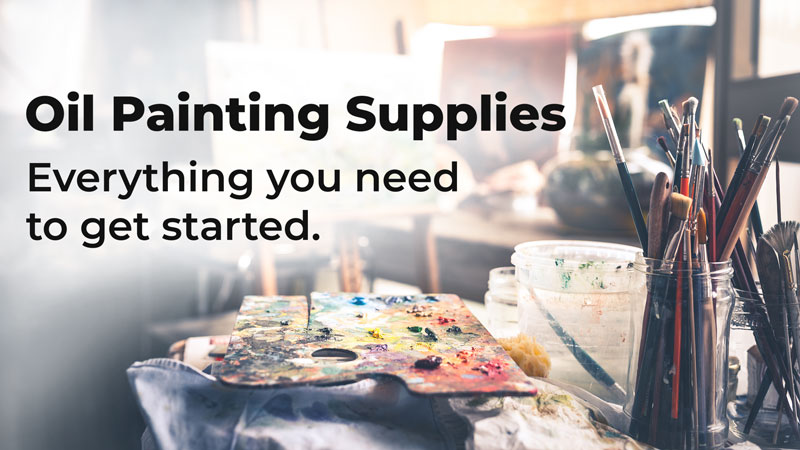
I remember my first experience oil painting. I was twelve years old and a family friend invited me to her house to make a painting. She had a lot of supplies. In fact, she had invested in an oil painting kit that is still available for purchase all these years later. It was a large Bob Ross painting kit. I had a great experience with the Bob Ross kit which included many more supplies than I used that day. That was thirty years ago. I’ve purchased and used countless oil painting supplies since then.
I would not discourage anyone from buying a comprehensive oil painting kit. However, you do not need to buy a kit just to get started. You can instead invest in some essentials and add to your supplies as you gain experience.
With some no-nonsense advice, you’ll be ready to choose individually sold supplies without buying what you will not use. First let’s consider the benefits of both painting-kits and also individually purchased supplies. Then we will identify some good options that are available in the marketplace.
Why buy an oil painting kit?
Kits are attractive. They’re easy, but often overpriced. Many times, they include materials or colors that you just won’t use. Some are better than others and some are worth the investment.
Here are a few reasons to buy a kit…
- It’s easy. The best thing about going with a kit is that you only need to make one decision – which kit to buy?
- The kit may include an attractive box or case that you can use for years.
- The extras – sometimes a kit will include basic information on techniques or a color wheel to assist in mixing colors.
Why buy oil painting supplies individually?
Although kits are easy and many have attractive extras, you may find that you save money and actually get more if you purchase your supplies individually. You also have more control over your “palette”.
Here are a few reasons to buy oil painting supplies individually…
- Sometimes kits include supplies that are not necessary.
- Better quality materials. Beginner kits are often stocked with lower quality materials.
- If you already have some experience painting with acrylic or watercolor, then you can choose pigments (paint colors) that you have experience using.
- It may be cheaper. The initial cost of individually selected supplies may be more than going with a small kit, but buyer beware. Many kits include smaller tubes of paint. Individually purchased tubes of paint may be cheaper by volume. You are also less likely to end up with colors you don’t really want.
Essential Supplies for Oil Painting
So, what are the essentials? What do you need to get started with oils? Let’s take a look…
To get started oil painting you need four things:
- Paint (and something to put it on and mix it with)
- Brushes
- A support
- A way to clean up
Let’s consider both a good option and the best option for each of these essentials. My recommendations are based on personal experience with the supplies mentioned hereafter.
Oil Paint
Oil paint, like all paints, is made up three main parts. These three parts work to make paint function in the manner we expect.
These three parts are…
- Pigment – This is the color. Pigment can be manufactured or come from natural resources. Often the concentration of pigment compared to the other parts directly relates to the overall quality of the paint brand. More pigment often means higher quality paint.
- Binder – Binder is the material that holds the pigment together. Most often, the binder is linseed oil.
- Solvent and other additives – Solvent is the material that thins paint and makes it viscous enough to be spread over a surface. A variety of solvents can be used including turpentine, mineral spirits, and other solutions of similar characteristics. Other additives are often added to improve lightfastness and the usability of the paint.
Lightfastness
Another thing to consider when choosing oil paints in the lightfastness of the brand. Lightfastness refers to the ability of the paint to resist fading when exposed to ultra violet. If the lightfastness is weak, then the colors will fade over time and won’t be true to the original painting. Since we want our paintings to last as long as possible, we look for paints with a high lightfastness rating.
You can find the lightfastness rating on the paint label. Look for the letters “ASTM”, which stands for American Society for Testing and Materials Standard. There are three levels…
- ASTM Level I – Excellent
- ASTM Level II – Very good
- ASTM Level III – Not considered acceptable as artist’s quality
Clearly, we want to avoid brands and colors with a rating of III. Levels I and II are more than suitable.
Permanence
Some brands, like Winsor and Newton, go a step further and include a permanence rating. This rating considers the lightfastness of the color but also the “chemical stability” of the paint. In other words, some colors are more permanent than others. Here’s how Winsor and Newton evaluates a color’s permanence…
- AA – Extremely Permanent
- A – Permanent
- B – Moderately Durable
Let’s look at a couple of options as far as brands go…
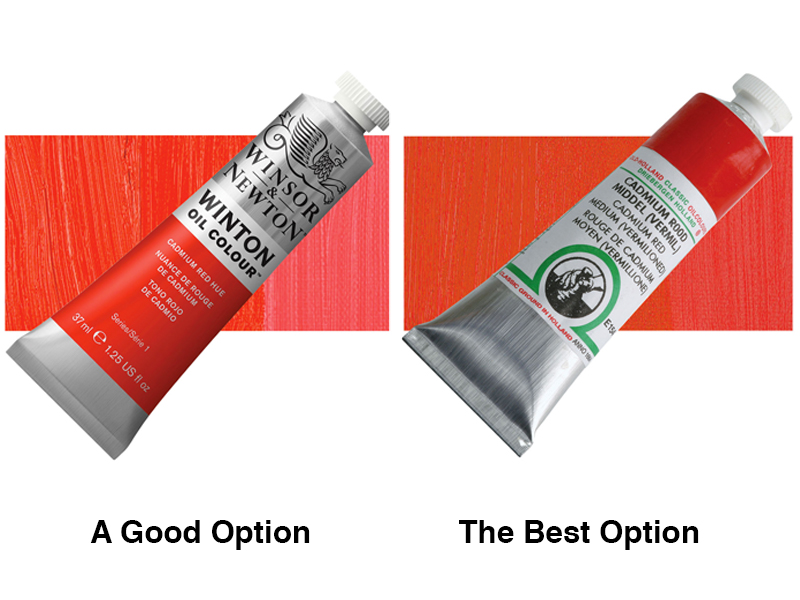
A Good Option – A good quality, cost conscious oil paint is the Winton Oil Colour line by Winsor and Newton. This line of paint keeps the price down by using “hues” in place of the more expensive pigments. For example, two of the pigments recommended are made from the metal, cadmium. Cadmium is expensive. Winton paint uses a substitute for those pigments. For this reason, Winton is categorized as a student grade paint. It is not, however, a low-grade paint. The various colors are consistent in both viscosity and mixing strength. They feel dense like top quality oil paints. Lightfastness and permanence ratings vary in this line, but all colors receive a lightfastness rating of I or II, with most having a rating of I. All permanence ratings are A or AA.
The Best Option – The best oil paint I have used is Old Holland Paint. It is pricey but it is amazing. Each tube is so full of pure pigment that you can almost hear it grind under the palette knife. All Old Holland oil paints are lightfast rated at level I or II.
Choosing Colors for Your Palette
If you are just getting started and are not sure what colors to buy, I recommend starting with only five pigments:
- Titanium White
- Ivory Black
- Cadmium Yellow Medium
- Cadmium Red Medium
- Ultramarine Blue
These colors will keep your palette simple while giving you the ability to mix a broad range of natural colors. Add pigments as you discover you need them.
A Palette
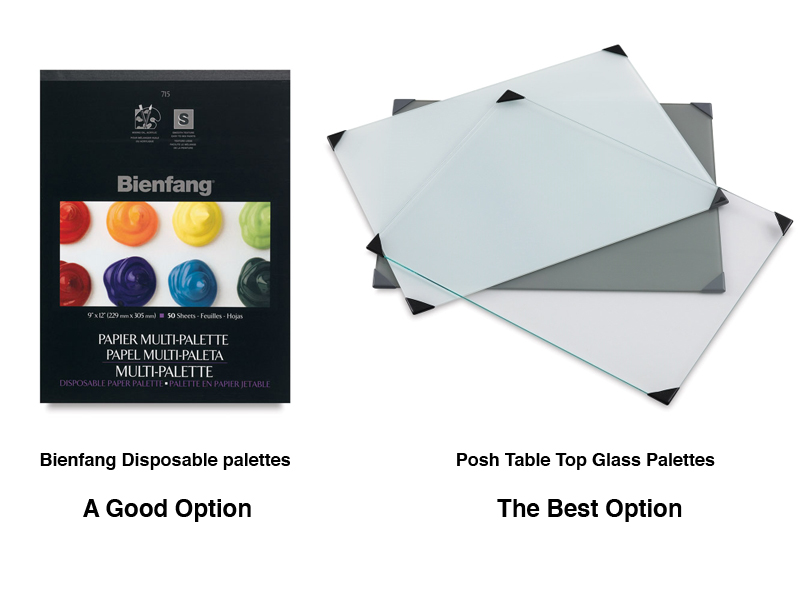
Besides paint, you will also need a palette. A good option for a palette is disposable palette paper. This makes clean up a breeze. The best option is a glass palette that you can wipe clean and even scrap with a razor blade should your paint dry.
Mixing Knives
Some artists prefer to mix colors on their palette with a knife. This is an optional accessory, but very useful for mixing large qualities of color.
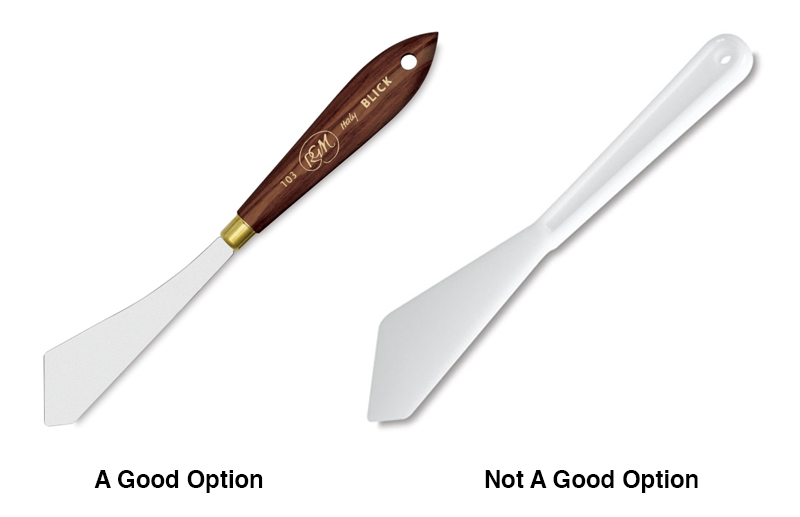
Oil paint is thick and more easily mixed with a palette knife than a brush. Never buy a plastic palette knife. They do not bend enough and dried paint is too difficult to remove. Instead use a metal palette knife. I like the style that is wider at the end.
Brushes for Oil Painting
Use bristle brushes for oil paint. A small nylon brush or sable brush is fine for details but you should apply the bulk of your paint with bristle brushes. They are quite stiff. Too soft a brush will not spread oil paint, which is like a dense paste.
Bushes come in several shapes; round, flat, bright and filbert being the main four. You should eventually try them all but this article is about getting started oil painting. For this reason, I recommend the filbert shape. Like the spork, it is a combination of two instruments – the flat and round brush shapes. Unlike the spork, it does a good job imitating both shapes. Use it like a flat or turn it sideways and use its profile like a round brush.
See also: All about painting brushes
Three bristle brushes are enough to start painting. Wipe them out with a dry rag or paper towel when changing colors. Choose sizes that are approximately 1/8th inch (5.5mm), ½ inch (11 mm) and 1 inch wide (25mm).
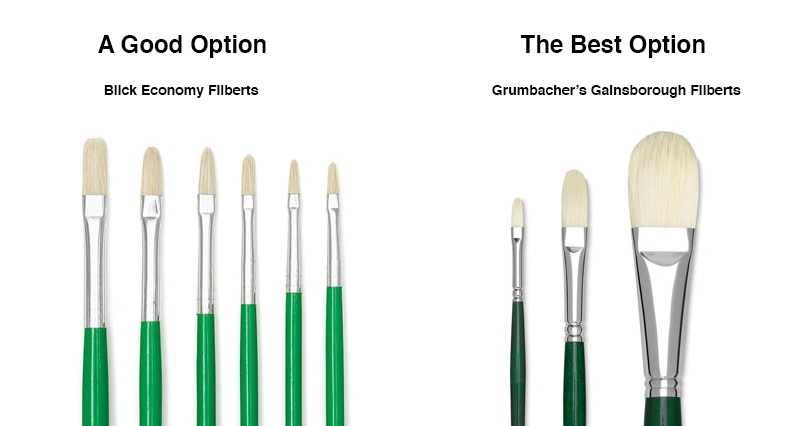
A Good Option – Blick Economy bristle brushes are a good option. The metal ferrule that fastens the bristles to the handle is a thinner gauge metal. More expensive brushes use higher quality materials but the bristles are likely to wear down from regular use before the metal ferrule fails anyway.
The Best Option – I’ve never been picky about my brushes. More important that buying the best brushes is taking care to clean them well. Doing so will ensure consistent performance for the life of the brush.
A high-quality brush that I’ve had the pleasure of using is from the Gainsborough line of brushes made by Grumbacher. These brushes last longer and are less likely to drop bristles onto your canvas while you paint.
A Support
We could all use some support from time to time. That kind of support, however, is not the kind we need to make a painting. In art, the support is the surface on which you paint. Oil painters use canvas, paper and wood supports; canvas being the more popular choice in this day and age. Canvas is a fine option but it is neither my “good” or “best” recommendation.
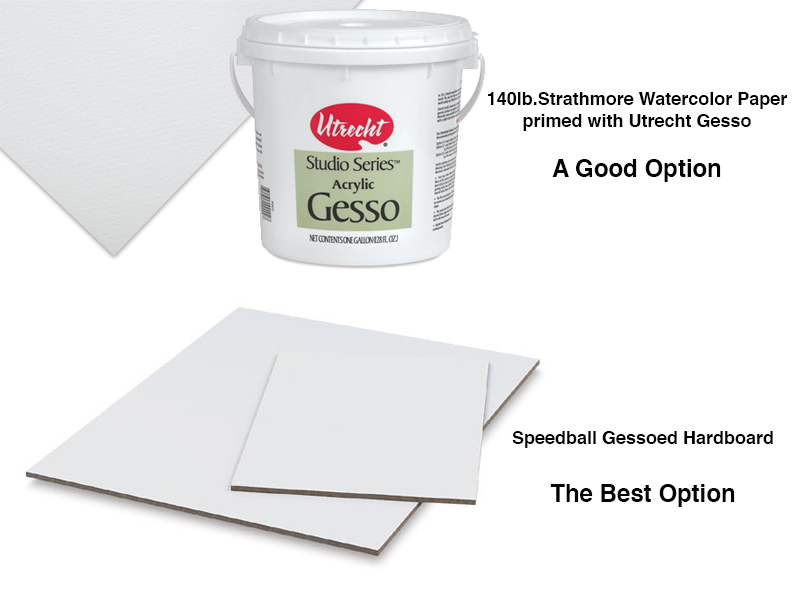
A Good Option – Eventually, you should try all types of support surfaces but to get started oil painting, I recommend using watercolor paper prepared with a layer of gesso. Gesso is a thick white acrylic primer that will protect the watercolor paper from the oil in your paint. I use Utrecht Gesso and Strathmore 140lb. watercolor paper. Once the primed paper is dry, just tape it to a drawing board or piece of Masonite and begin painting.
Gessoed watercolor paper is a common support in art schools because it is less expensive than canvas. Don’t think that oil painting on paper is meant for beginners only. Many experienced oil painters prefer gessoed paper over the alternatives.
The Best Option – In my opinion, the best surface to paint on is wood that has been gessoed. Wood is more durable that either paper or canvas. Over the years, I’ve had a few accidents in the studio resulting in punctures to paintings on both canvas and paper. In each case, a painting on wood would have survived. I usually gesso my own wood supports, sanding lightly between layers but some art supply companies are getting in on the trend. Speedball sells prepared hardboard supports in most standard sized.
Painting on wood supports has not been as popular since the Renaissance (Da Vinci painted on wood).
A Way To Clean Up
Oil and water do not mix, so stronger solvents are used to clean oil brushes and such. For this reason, some beginning painters avoid oil paint all together. That’s too bad because cleaning up with a solvent is not harder that using water. For those that are still hesitant, you can clean oil brushes in cooking oil (canola oil is fine) and then use a bar of soap to remove the cooking oil – no solvent required. This is a good option if you are hyper-sensitive to solvents but not my recommendation, though I’ve used cooking oil many times.
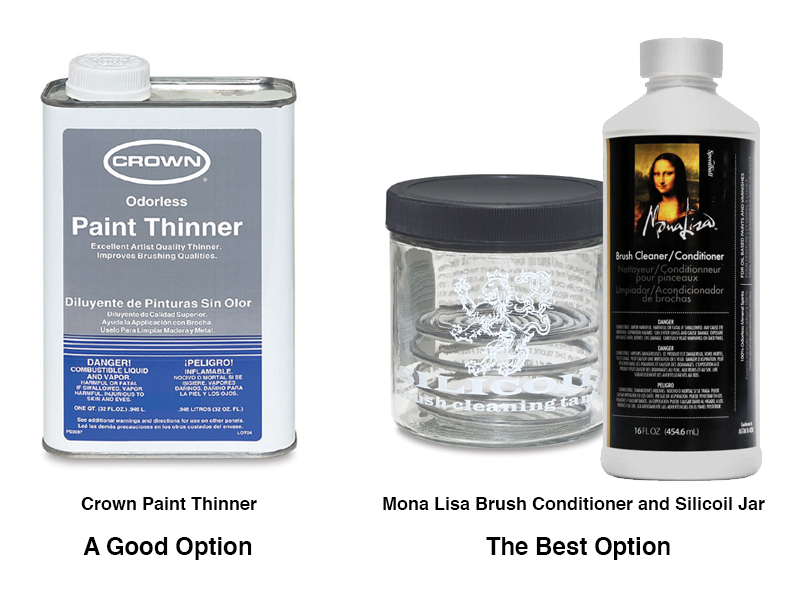
A Good Option – Crown odorless paint thinner, available from both art supply vendors and big-box hardware stores is a good option. It is cheap and has less fumes than either mineral spirits or turpentine (your grandparent’s solvents).
The Best Option – The best brush cleaner that I have used is Mona Lisa silicone brush cleaner in a glass brush-cleaning jar. This brush cleaner does not dissolve the paint but slides it right off of the bristles. It even has a pleasant odor.
Bonus Oil Painting Supply – Medium
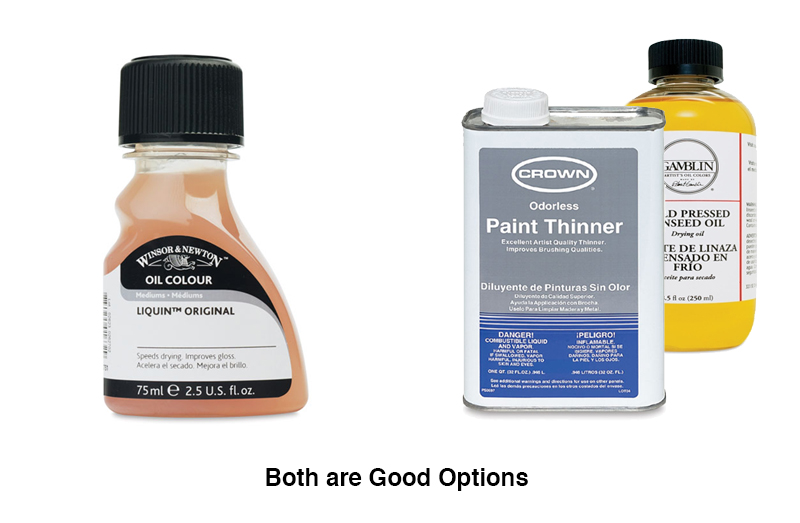
Many oil painters use medium (part linseed oil, part solvent) to thin their paints so that it is easier to spread. I am not including medium as an essential supply because I usually paint without medium. You should try painting with and without medium to see if you like having the option to alter your paints viscosity. When I do use medium I either use Liquin By Winsor and Newton, or I mix my own at a 50/50 ratio, linseed oil to solvent. Gamblin’s cold pressed linseed oil is a good choice.
There are so many art supplies out there that it is hard to know what to buy. If you are getting started oil painting then save yourself some grief and give my recommendations a try. They work for me and I’ll bet they’ll work for you too.
If you’re looking for lessons to get you started, be sure to check out all of our oil painting lessons.
If so, join over 36,000 others that receive our newsletter with new drawing and painting lessons. Plus, check out three of our course videos and ebooks for free.


